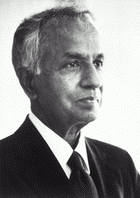Year born: 1910
Research Areas: Stellar Evolution, Black Holes
"My motive has not been to solve a single problem, but to acquire a perspective of an entire area"
Source: Anand, A (2013) Indian Nobel Laureates, Ocean Books, India

Early Life
Subrahmanyan Chandrasekhar (known as Chandra) grew up in Lorhre, British India (now Pakistan). Chandra came from an academic family. His uncle was a physicist and Nobel Laureate and his mother loved learning. She encouraged young Chandra to be curious. His mother and father taught him at home until he was 12. Chandra got a BSc in physics in 1930 from Presidency College, Madras. He then won a scholarship to study for a postgraduate degree at Trinity College, University of Cambridge, UK. He received a PhD in 1933.
Career Highlights
Chandra combined his knowledge of maths, physics, and astronomy to investigate what happened to stars when they run out of fuel. He calculated what is now known as the ‘Chandrasekhar limit’. This is the maximum mass that a white dwarf star can have and remain a white dwarf. Any bigger and a nuclear explosion occurs on the surface of the star creating a type Ia supernova.
Chandra first proposed the idea that stars would collapse during the first year of his postgraduate studies. In fact, Chandra did a lot of the work on a boat from India to the UK, before his 20th birthday. Not all astronomers accepted Chandra’s idea that stars would collapse. Sir Arthur Eddington told a conference audience “I think there should be a law of Nature to prevent a star from behaving in this absurd way!”. Chandra was proved correct and scientists accept the ‘Chandrasekhar limit’ to be 1.4 times the mass of the Sun. If a white dwarf star exceeds that limit, it explodes in a huge explosion called a supernova.
Chandra moved to the USA in 1936 and worked at the University of Chicago for over 50 years. He worked on many topics including the motions of stars, general relativity, and the maths of black holes. In 1953, he and his wife became American citizens.
Legacy
Chandra won the Nobel Prize for Physics in 1983. The NASA Chandra x-ray space telescope and the Himalayan Chandra Telescope are named after him. The asteroid 1958 Chandra is also named after Subrahmanyan Chandrasekhar.
Other Interests
Chandra and Arthur Eddington were friends despite their disagreement. They watched tennis at Wimbledon and went on bike rides in the countryside. Chandra’s hobbies included reading literature and listening to music. He particularly enjoyed orchestral, chamber and South Indian music.
